Fruit enzymes (citrus peel bio enzymes) also called garbage enzymes are produced from fruits peels or waste. It is a natural multi purpose, chemical free, eco friendly cleaner. It is biodegradable and eco-friendly alternative to harsh chemicals. Many products that we use in our everyday life like drain cleaners, floor cleaners, dish washing detergents, phenyl, bleach etc contains toxic chemicals which are hazardous to our health and to the environment. It exposes us to many harmful chemicals that have been linked to various health problems and allergies. It is not possible to keep chemicals totally out of our house but we can to some extent, if we take some efforts. I love living close to nature as much as possible and always try to use natural products as much as I can in my daily life. I came to know about this citrus enzyme cleaner through a foreign magazine. I found it appealing and did more research about it and made my own non toxic fruit enzyme cleaner. It is not only easy to make but all the ingredients are easily available in our kitchen and it costs absolutely nothing. These enzyme cleaners are natural, toxic free, chemical free, hence very gentle on the hands. Today let us learn how to make this wonderful, non toxic, eco-friendly, homemade Natural Cleaner/Citrus cleanser.
Eco Friendly Citrus Cleaner
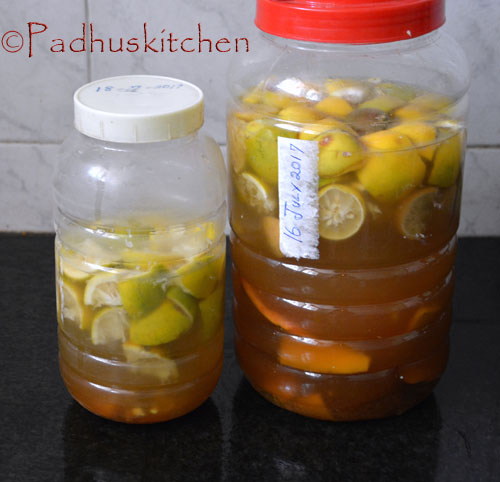
Prep Time : 10 mins
Recipe Category: How to-Useful Tips
Author: Padhu Sankar
Ingredients needed
Lemon or orange peel – 300 grams
Jaggery or Brown sugar -100 grams (powdered)
Water – 1 liter
Yeast – 1 tsp (optional)
2 liter plastic bottle with a tight lid
Method
Cut lemon or orange peels (you can use pineapple peels also) into medium sized pieces.
Grate jaggery or you can use powdered jaggery or brown sugar. (do not use white sugar).
Take a plastic bottle with a tight lid. (do not use glass bottles as gas build-up from the fermentation process might cause explosion).
Add jaggery and 1 liter of water.
Add the citrus peels and yeast. Make sure there is a little space on the top. Fill the container only up to 80%. Close it tightly and shake it well.
Label the container indicating the date on which it was kept for fermenting.
Leave it to ferment for 3 months. If you add yeast, it will take only 2 months for the fruit enzymes to be ready.
You have to open the lid everyday for the first week to prevent gas build up and close it again, otherwise the gas will build up to explode in the container.
From the 2nd week, you can open it on alternate days and close it back tightly.
After second week, open the lid once in a week to let the gas out.
Store it away from sunlight in a warm dry place. It will take 2 months (if yeast is added) or 3 month (if yeast is not added) for the citrus enzyme cleaner to be ready for use.
After 3 months, strain it using a cloth or a sieve. The liquid collected is the fruit enzyme and can be used as a non toxic multipurpose cleaner.
Note
To make bio enzymes quicker, you can add a tsp of yeast. In that case the enzymes will be ready within two months time. (I have added yeast, so mine was ready in 2 months time).
The measure is 1 part Jaggery/brown sugar + 3 parts fruit peels + 10 parts water. Even when making a large batch, maintain the same ratio.
Though you can use any fruit peels, I personally prefer to use only orange, lemons and pineapple peels/waste. You can either use them together or separately. Using citrus fruit peels alone gives a nice citrus smell to the enzyme cleanser.
Do not use glass bottles.
Avoid adding rotten fruits or dried peels. Use fresh peels for making fruit enzymes. (You can collect and store the peels in the refrigerator, till you get the required quantity. Bring it to room temperature before adding).
Fruit Enzyme/Citrus enzymes has no expiry date. You can use it lifelong.
How to use the fruit enzyme cleaner
Multipurpose Cleaner – You can use the fruits enzymes as a multipurpose cleaner. Dilute it in the ratio 1 : 10 (one part citrus enzyme cleaner with 10 parts water) and use it to clean anything like tiles, bathroom, gas stoves, toilets, kitchen sink, mirrors etc.
Use it undiluted for stubborn strains, grease etc.
Washing vegetables and fruits – You can dilute it in the ratio 1:20 and use it to wash fruits and vegetables.
For mopping floor – I use 1/4 cup of fruit enzyme for a bucket of water and use it for mopping floors. When used regularly it helps to keep ants at bay as the cleaners are natural insect repellents. I stopped buying phenol and other floor cleaners, after I started making this fruit enzyme.
Car wash -You can dilute it in the ratio 1:20 and use it to wash cars.
For cleaning vessels – I mix citrus enzyme cleaner with with soap nut (reetha in Hindi or boondikottai in Tamil) water and use it to clean vessels.
The residue can be used as a fertilizer. Dry it well and mix it with soil. You can put it in your composting bin or you can use a little of it as an accelerator for making the next batch or you can grind it with a little baking soda and use it to clean kitchen sink or discard it.
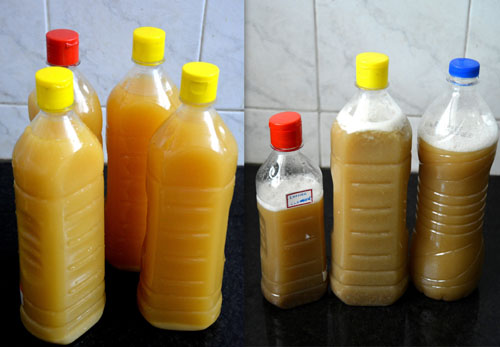 |
| Left – Fruit Enzymes ready for use. Right – Fruit enzymes mixed with soapnut water . |
This is yet another simple step to reduce the use of toxic chemicals in our homes which is not only good for us but also for the environment.
You can check my post on
How to clean kitchen sink without using toxic chemicals
How to compost kitchen waste using khamba/pot
How to compost kitchen waste without khamba
If you found this post useful, I would really love it, if you pin it or share it with your Facebook fans or Twitter followers or Google+ circles or Instagram today. All it takes is a simple click on the “pin it” “like,” “share,” “tweet,” or Google+ buttons below the post. Thank you!

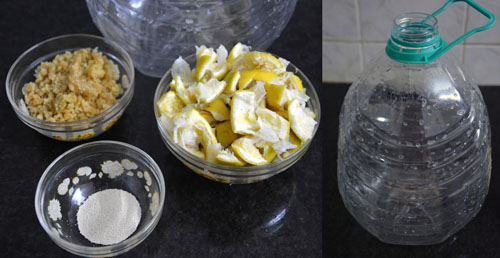
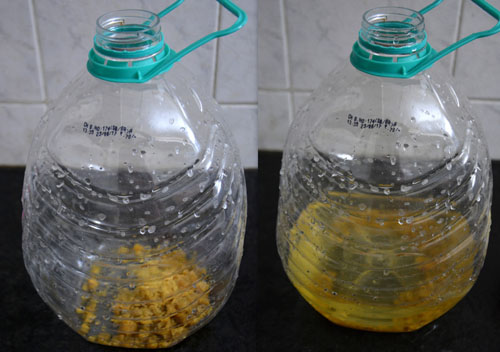
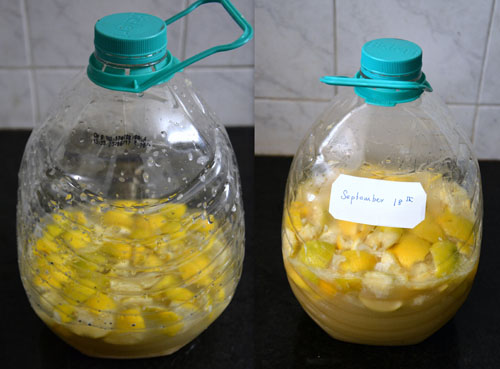
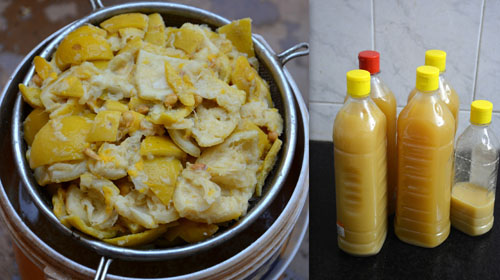
This is super duper awesome. Very interesting. If used as a dish wash liquid,how many days a bottle lasts?
Very useful information.Thank you. I am searching for this chemical free cleanser for a long time.Maam can we use whole fresh fruits instead of peels. Because merely getting peels will take a long time.
Why you want to wast fruits. If you drink orange juice for 3 days, you will get the required quantity.(just 300 grams).
Hi I have never seen anything like this. Really good idea. Saves our planet. Should be shared alot.
Hi Padhu, Very usefull post.. thank u so much….
Thank you Padhu for your excellent work of this ecofriendly products
How to make dish cleaning soap using reetha?
Will soon share how to make it.
Excellent post
Super post
Thank you ,very very informative
Very good effort. Admire u a lot in ur gardening post and eco-friendly podt
wow very nice its imaginable thank a lot
Shall we use this as washing liquid for clothes?
Yes, you can. I mix it with little soapnut water.
Hi padhu, if we add soapnut water won't it spoil?what about its life? How many days we can store it after adding soapnut water
No, it will not get spoiled, if we mix it with enzymes. Mix only what is needed for a week. I am doing a detailed post on it. Will soon publish it.
Oh wow….i was looking out for something like this….but was waiting for someone to authenticate…if its from you…no doubts..i will do it…thanks a ton Padhu
Thanks Padhu.. amazing recipe.. but can we make this in a plastic bucket with loose lid?
What yeast should we use? Dry yeast?
Yes, you can use dry yeast.
Hi
Why are we using jaggery powder. Will ot attracts ants if we use it for mopping floors.
Nice method actually thanks for sharing
The jaggery is the food for the microbes. Once it is fermented, it will not be sticky nor will attract ants. I am using it regularly with a little soap nut liquid. In fact it also has insect repellent properties.
Hi, can we use few drops of this liquid to mix it in kids bathing water.. Instead of soap..
You can use soap nut liquid for bathing kids instead of soap. Check my post on how to use soapnuts in the "useful tips" page.
Hi .. tried the bio enzyme,the end liquid has spoilt fruits smell even when I used in dilution..for kitchen tiles I mixed with soapnuts solution..the entire kitchen was smelling of rotten fruit smell.did I go wrong somewhere.i used yeast to hasten the process and used amla to as I had at home .. thanks
Follow the recipe as it is. I am doing it for nearly 2 years and do not have any such problems. Do not add amla.
I prepared citrus acid cleaner as per your recipe. It came out well.. a big thank you padhu
Hi. Will ants be attrached if we add jaggery?
No.
Can we use the enzyme cleaner on wood also??
why dont we use plastic free bottles for containers,also?
The air build up due to fermentation might explode the bottle, so we use plastic containers.
How long will the soapnuts soaked in bioenzyme will last in room temperature??i soakes soapnuts in bioenzyme for a week,grinded the soapnuts,filtered and added back to enzyme. It smells bad after 2 weeks
I mix it for a week not more than that. Soapnut liquid has to be refrigerated. Bio enzymes stays good at room temperature. Mix soapnut liquid as and when required with bio enzymes.
Ma’am since passion fruit also has citrus properties, can I use passion fruit outer skin to make this enzyme
Use only citrus fruits like oranges, lemons and pineapple. Though you can use other fruits, personally I do not recommend.
Madam can we add musambi peels
Yes, you can add.
Padhu, how do you make soapnut water? Boil soapnuts in water and strain? If so, 1. what proportion of soapnut to water and 2. how long does one boil? 3. Can I compost the boiled squeezed soapnut? 4. What proportion soapnut water to bioenzyme cleaner? Thanks and sorry for so many queries 🙂 Rgds, Anjali
Watch this video in detail https://youtu.be/uwUUbY4I2kE
I have mentioned everything in detail.
Ma’am how can we make it soapy and dense ? And also what is the the way for its packaging?
Hi finally bioenzyme is a acetic acid what’s difference between banana bioenzyme and citrus bioenzyme
Shall iWater melon peel for bioenzyme is there any difference in cleaning
I do not recommend that though you can add. I prefer only citrus fruits.
Is there an alternative to soapnut? I started mine in Feb and didn’t expyeft lockdown! Now am short of dishwashing liquid also. Pls tell me if there is a homemade substitute for soapnut
Soapnuts are the only natural soap.
Is it necessary to add water?
Follow the exact measurements. It turns out well.
By the way Padhu, where did you get the tagine from? I am looking for buying one.,I have no idea where it is availabile in India. You don’t have to post this comment. If possible please reply to my mail I’d.
My son got it for me from Morocco when he went for tour there.
Hi
I don’t have Jaggery… And used white sugar instead.. Would it turn out OK?
No use jaggery or brown sugar.
How do I know the final product is ready
Can mosambi peels be used?
Yes, it can be used.
I am trying for first time and getting a strong pungent smell and ithas a frothy top layer. Is it normal?
Use only citrus fruit peels. Just mix it well. Follow the instructions given. Don’t worry, it will be fine.
Hi,
Just a feedback. When I mix soapnut solution with bio enzyme, gas formation happens. how can I avoid this
hi Mam,
I am going to try this. for washing vessels can i use with soapnut powder instead of soapnuts. Because i am in Singapore and i dont get soapnuts here.
Pls tell me the proportion if i can use soapnut powder.
And sometimes can i use the citrus fruit pulp also when peels are in shortage. Please reply. Thanks.
You can use soap nut powder also if available. No proportions for that.
This is awesome!. Really great. Let me know how to use soapnut mixing with bio enzyme.
There is no particular ratio. I have mentioned it here. Please check that
https://www.padhuskitchen.com/2018/03/how-to-use-soap-nuts-for-cleaning-soap.html
I used a glass bottle in the ratio provided initially (before in read this post). Later transferred all the contents to a porcelain container (jaadi) and let it sit for 2 months. When I examines the content. I see a fungus kinda layer on the water and some worms on the side of the container. Is this normal?? 🙁
Seeing worms is not normal. Discard it. If you follow the recipe exactly, you will not get worms. Use only plastic bottles.
Hi Thanks for nice post about garbage enzyme. I have 2 questions
1. Do we need to or can we shake the mixture every alternate day or we need to keep it undisturbed..? I have used a 20 l plastic bottle and rubber band to close the plastic bottle.
2. What is the shelf life after adding boiled soapnut water? Is there any way such as adding a preservative to increase shelf life to 6 months or a year? Which preservative?
Yes, you have to shake it every 4 or 5 days.
Add soapnut water only to needed quantity and use it. Citrus enzymes have no expiry day but when you add soap nut water, use it at the earliest.
Hi,
is this the same that can be used in gardens as well ?
Yes but dilute it well.
We must add one tea spoon of yeast For 100 grm jaggery , 300 grm orange peel 1 litre water .If I want to make 10 times of the same at a time how much yeast to be added ?
Actually it is not necessary to add yeast at all. To quicken the process of fermentation, we are adding yeast. If you want to make 10 times the same also, just a 2 tsps of yeast.
Hi I have made the bio enzyme but it has rotten smell. Not sure if i have made anything wrong. Also when can we know that it is ready to use??
It does not smell rotten. Did you add peels of other fruits. You must follow the exact measurements for it to be successful.
Hi, Can i add the orange skins (not the peel) which hold the pulp?
Don’t add the skin, add only the orange peels.
Hi Padhu!
Thanks for the detailed recipe. I have a quick question (similar to Sonam’s question above) – in your video https://www.youtube.com/watch?v=uwUUbY4I2kE when you look closely (at say 0:44) I see that the lemon peels you are using have a lot of pith and inner skin included, not just the outer peel. Am I seeing incorrectly? So it IS okay to directly use the lemon after squeezing out the juice – no need to remove the inner skin and pith with a knife??
And second question – this bioenzyme cleaner – how should one store it, and for how long? Room temperature, indefinite amount of time, or something else?
Thanks for the clarification!
1.You don’t have to remove the inner pith. You can use it as such after squeezing it.
2. Store it at room temperature (avoid keep it in the sun or where there is sunlight).
3. You can store the final product (that is) bio enzymes after filtering it for indefinite amount of time. There is no expiry date for bio enzymes.
Thank you so much for the clarification. I will be preparing a batch of this based on your guidelines 🙂 — hope it comes out well !
By the way, I love your traditional recipes in the blog. Living in the US, so any thing closer to home and our culture that you post, makes heart so happy. Just reading about it, and of course, trying it out! Very inspiring. Thank you for all the care you invest in posting these precious gems from the past. I can only imagine the kind of time and effort you put into each post!
(Apparently, bioenzyme too is used in villages in India — I don’t know if it was traditional to our culture in the past, but I know some villages in Garhwal do this, so it’s not just a Western concept… )
Hi Padhu,
I prepared this as per your instruction. I noticed that the lemon peels were kind of floating in the jaggery-water mixture. But since I followed the instructions I let it be. This was around 2.5 weeks back. Now, I notice a white deposit on that small surface area of the lemon peels facing up, that are exposed to the air. I know they say fermentation is tricky if fungus or mold develop. Is this what has happened you think, and I need to just throw it now and prepare another batch?
Were your lemon peels totally immersed in the water? Hard to tell from the pictures clearly. Mine are mostly under the water, but they are all floating inside. And a few peels came up partially-exposed – whatever number the small surface area my narrow-mouth bottle allowed.
Would be grateful for your help. Don’t want to mess the second attempt!
PJ
No, I am doing it for years. I have not got fungus. The lemon peels should be immersed in water. Everyday you should shake it, open the lid and close it for a week. Check my detailed video on this https://youtu.be/uwUUbY4I2kE
Yes, thank you, I had been that video before starting.
When you say “immersed” are yours completely submerged and far away from the surface of the water, or do they kind of float, with a few of them floating just below the water surface?
Seen the video. Sorry for typo.
So getting a white coating on the top few peels that are partially poking out of the water means I need to throw it out, make another batch, right?
Not necessary. Try shaking it. As I use only citrus peel, I have not got the fungal issues. But those who use other fruit peels have fungus problems but they continue to ferment it.
Can we use freshly cut lemon instead of squeezing out the juice and using only peels? I have this question because i want to make it in large quantity at once and using so many citrus fruits at once is not possible so thought of putting the enitre lemon itself. Will it work or only peels should be used?
Only peels – all citrus fruits you can use.
Hi Padhu can I use distilled water in Citrus Enzyme?
Thanks
Renu
Plain water only.
Hi Padhu,
How to collect citrus peels for making bioenzyme, I get one or two peels everyday. If I keep it as such it becomes dry. Can I just place in water, will it last till I get a sizable amount to make enzyme.
Thanks
Collect and keep in the fridge. Once you get 300 gms, you can make fruit enzymes.
Can u share pictures of every month how bottle looks? Mine has some white layer on it. That’s ok right? The day it is done it should look white on top or what? I did add yeast into it without warm water. So it will take 2 months?
Check my video on padhuskitchen youtube channel. Yes, if you add yeast, you can strain it in 2 months time.
Hi padhu
It’s a little odd calling padhu coz my name is padmapriya and friends call me padhu. I just have a doubt . I stay in a very remote location here there is a tree with small narthenga( Citron) . Can I use that and natusarkarai to make bioenzyme .
You can use citron. Use only jaggery.
Why can’t we use white sugar?
Hi padhu
Can i use lemon bioenzyme for washing clothes ( enzyme prepared only with lemon peels)
Yes but not for white clothes.
Hi i love your YT vdos. Is it normal to have a kahm formation on the top?
It is normal but if you shake it everyday, it will not form.
Thank you for the detailed information. Is it possible to do this at large scale for business purposes and can be used as Sceptic bio enzyme cleaner or treatment.
Hi, I have kept many citrus peels in the sun to dry and now planning to make the citrus enzyme. Will it not work with dried peels ?
No, it will not work. You should not use dried peels.
Padhu, thanks for the detailed videos.
please guide can i use hibiscus powder to make bioenzyme, as fresh lowers are not available. thanks
Hi Paddu,
Can I use concentrated citrus bio enzyme alone for dishwashing or compulsary need to use along with soapnut.
Soapnut is not necessary. Since everyone is used to foam and they cannot accept just bio enzymes which doesn’t foam at all, I have added soapnuts.
How many days we can use this liquid once it is ready after 3 months?
I have taken jagerry, fresh orange peels and water in 1:3:10 ratio in a airtight plastic container.
In container added peels, solution of jagerry in water and mixed well. Kept airtight.
But, even after 7 days no gas formation observed.
I opened the container slightly, colour of solution, peels, was normal. Nothing any abnormal. Added slightly jagerry and mixed well.
After that also, no gas formation occurred. It is now 15 days since batch started.
What is the problem.
What is the future of the batch?
Is addition of extra jagerry correct?
I have take bio enzyme batch with ratio 1:3:10 using jagerry, fresh orange peels and water in airtight plastic container. Jagerry added as solution in water.
Even after 7 days, no gas formation occured. I opened container slightly. Colour of peels and solution was normal. No abnormality of any kind observed. Even then I added small quantity of jagerry.
Now, even after 15 days (7 days before jagerry addition and 8 days after jagerry addition) there no gas formation.
What may have gone wrong?
Is it normal?
Though there is no gas formation, can I get good quality of Bio enzyme (as if there was gas formation) or low quality of enzyme will form?
What precaution should I take for next batch?
Check my video on bio enzymes in Padhuskitchen Youtube channel
Citrus bioenzymes
https://youtu.be/uwUUbY4I2kE
Nice detailed article for persons like me. Today I will make bio enzyme with the peels I stored in my freezer for more than one week. If you have written detailed article for making compost please share the link if not please do.
Thanks a ton
Thank you. Link for how to compost
https://www.padhuskitchen.com/2009/11/how-to-compost-naturally.html
Hi mam,
I have prepared citrus peels Bio enzyme yesterday.
1. Can i add peels in between also i.e., whenever i have fresh peels ?
2. Is that mandatory to cut the peels while adding ?
3. What happens if the proportions are slightly varying?
Avoid adding peels in-between. Collect n keep it in the fridge. Once you get the required quantity, make bio enzymes.
Cutting the peels is not mandatory.
As far as possible stick to the measurements. If there are slight variation, it does not matter.